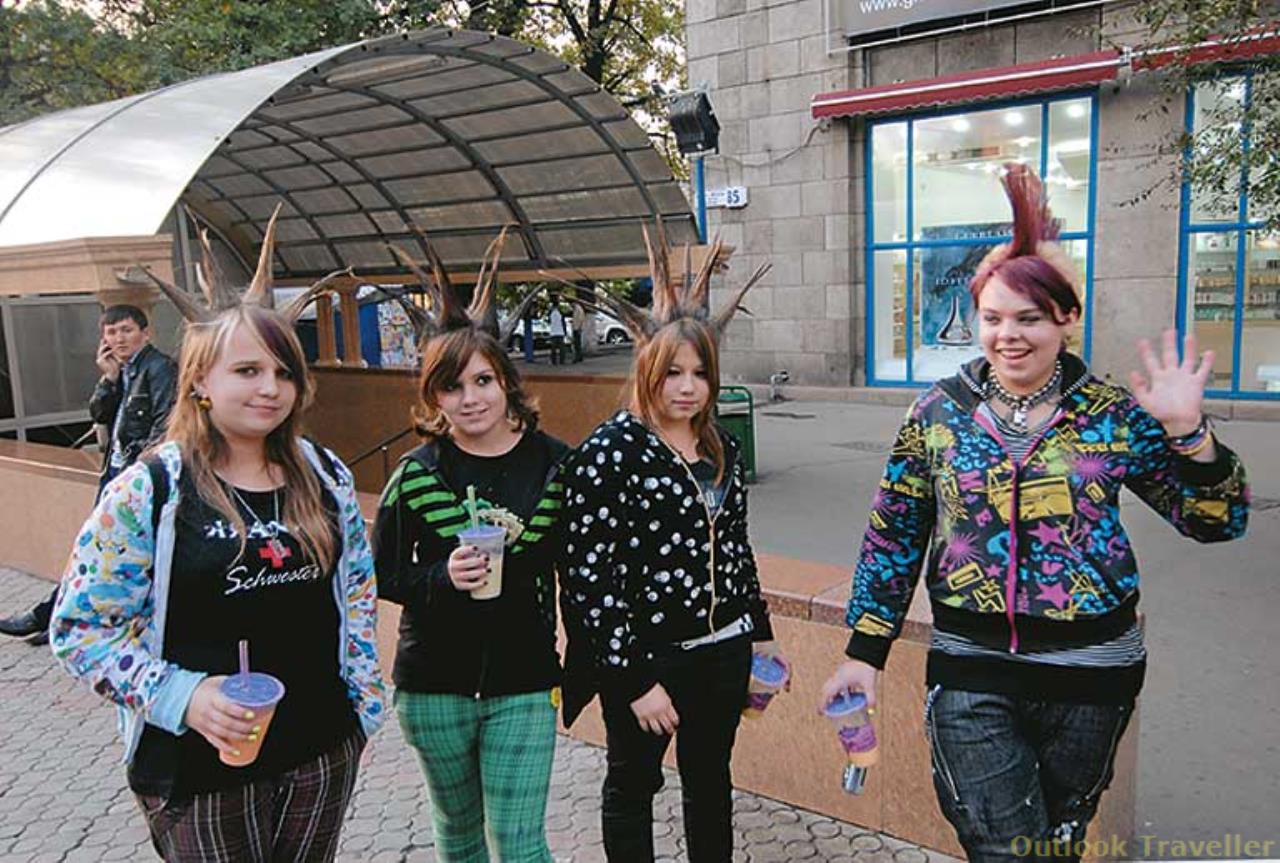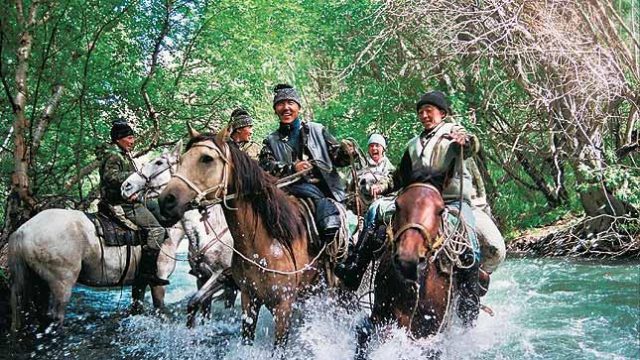There’s a genre of computer game called the city-building game; the SimCity and Caesar series are good
There is no city in the world that reminds me of this type of game as strongly as Astana (meaning capital), the new capital of Kazakhstan. The city is to be completed by 2030; as of now, it’s a slowly filling, bewildering grid of roads, bridges and massive buildings built by eccentric architects, bizarre megaliths that will house embassies, oil corporations, rich residents. Vast stretches of empty land will soon be covered by giant towers. When the city is finished it will be, architecture-wise, a unique blend of Europe, the Arab nations, the Far East and Mars. A huge football stadium with a sliding roof, a mega-aquarium. A tent-like tower that looks like a giant mosquito net now will be a huge artificial beach resort full of imported sand and water.
At the centre of all the madness is a huge pyramid, the Palace of Peace and Reconciliation — actually, it currently stands forlornly in the middle of not very much, but 20 years later, when the crazed game-architects finish their SimAstana, it’ll be the four-sided, stained-glass-dove-covered pinnacle of everything. When we visit the pyramid and take the diagonally sliding lift to its various levels, its marvels are revealed — there’s a large opera house where a performance is being prepared for Nicholas Sarkozy. Upstairs, either a wedding or a conference of world leaders is being planned; either way, it needs a lot of chairs. Not far away is the Bayterek Monument, a tall pillar that’s lit up in many colours at night. On top of it is a huge golden sphere, signifying an egg laid by a mythical bird on top of a large tree. It’s all very symbolic; human desires are unattainable, it says.
The first thing you need to know about Kazakhstan is that it’s the ninth largest country in the world. It’s full of minerals and oil and business from all over the world looking to own a piece. The Kazakh population, though, is about the same as that of the greater Kolkata area. Most of the country is under construction. Tall, shiny, futuristic buildings everywhere, seemingly air-lifted from Dubai, Kuala Lumpur or Gurgaon. Even the monuments are mostly covered by scaffolding.
The heart of Kazakhstan, though, is not Astana. It’s the former capital, Almaty. It’s earthquake-prone and the air features a distinctly visible band of brown pollution, but it’s the cultural and business centre of the country. The government has mostly moved out, giving up their sprawling Soviet-style official mansions to universities and oil corporations. Almaty’s history, like most of the nation’s, is one of periodic razing and reinvention. The Mongols destroyed the oasis it was first built around twice; every political upheaval in the USSR and subsequently the CIS caused widespread reorganisation and renaming, and if that wasn’t enough, most of the city’s greatest buildings were destroyed by earthquakes in 1887 and 1911. The ethnic mix was often changed during the Soviet era through deportations and mass killings; large numbers of Koreans were resettled in Kazakhstan, adding to the already diverse population: Kazakhs, Russians, Turks, Uighurs, Tatars, Uzbeks, Germans and several others. The Soviet Union kept the nation on edge, unwilling to let a distinct identity be formed, potential Kazakh nationalist leaders were often ‘removed’ or exiled during Stalin’s years in power. Perhaps as some form of cosmic justice, Almaty was the place where the USSR died in 1991. Almost two decades later, the few Kazakhs I had real conversations with, while happy with their increased sense of freedom, aren’t sure what they feel about the drastic changes the country is now undergoing.
Rapid renovation is removing most traces of the Soviet era from the central parts of the city; Almaty is definitely more Western Europe than Soviet Russia. Almost everyone is fit and fashionably dressed; nearly every woman is in high heels. When we pass through the outskirts, though, the cars, buildings and signs bring back vague memories of photographs from Soviet books. A lot of the Soviet history I absorbed during the ’80s was about events that took place in Kazakhstan; for instance, Yuri Gagarin’s space flight took off at Baikonur Cosmodrome and Leon Trotsky was exiled to Almaty. And the small towns around Almaty still have that grey, slightly grimy USSR flavour; the cars are old and box-like, the faces are grim, the clothes a little tattered. These aren’t people who would fit in the Star Trek-like environs of Astana; they’re Eastern Bloc denizens not quite sure what to do with the 21st century.
“My classmates and I used to spend hours standing on Almaty Arbat (a nickname given to a central pedestrian street in Almaty, after a famous promenade in Moscow) because new shoes would come in from Prague. It’s so different now,” says Hamida, a 63-year-old Tatar whose husband is a retired Soviet Colonel. The promenade is flanked by malls and big shiny shops; the only thing saving it from complete degeneracy is the absence of McDonald’s. Far more interesting is the nearby Green Market, where hundreds of stalls are full of local food, a bewildering variety of meats, milk products, dry fruits and pickles. The sellers are just as diverse. I try a dry snack made of fermented mare’s milk, a favourite of nomadic Kazakh horsemen for centuries. It’s incredibly sour, but not unpleasant.
Another ancient Kazakh nomad tradition that has survived the ages is the practise of stealing a bride. In the good old days, young men would simply kidnap a woman and keep her in their tents for a day or two to seal the deal; now, though, the whole process is highly formal and bookings have to be made months in advance. In both Almaty and Astana, we saw dozens of couples getting married at the city’s wedding halls. Mostly Muslim weddings, but the brides wore white gowns. Long stretch limos line the streets outside the wedding halls; in Almaty, the couples travel to Panfilov Park afterwards, to obtain blessings in front of the eternal flame that burns in memory of a few Kazakh soldiers who died so the Nazis would never reach Moscow. It makes a startling picture; festive parties, sometimes with musicians and children with balloons, dancing and taking photographs in front of huge, grim soldiers of black stone bursting out of a wall.
There is a noticeable absence of camera-wielding Japanese and monkey-capped Bengalis, which means the tourism industry in Kazakhstan is just beginning to take off — which is possibly why the locals are still largely friendly. Very few people speak English, though this is changing rapidly. Air Astana, the national airline, has been given the responsibility of promoting the country as a business and leisure destination. Ski resorts, casinos and other oases of the quick-travelling, hard-partying businessman are beginning to mushroom around the major cities; we were taken to a few. They’re mostly empty now. In Almaty, though, the citizens are taking to the new nightlife with a passion. Nightclubs thump out Kazakh pop and ’70s disco as sharply dressed young Kazakhs gyrate enthusiastically. Strippers grind away in separate enclosures. Multi-cuisine restaurants serve horse meat, steaks, salmon and belly dancers. The wine lists are long, but the vodka lists are longer.
New Kazakhstan, though, isn’t all about the pizzazz. Kazakh youngsters seem full of pride in their country and its exciting possible futures. Olga Park, 23, wants to be a journalist but works in PR because state-run TV would be too dull and full of placid pro-government reports. But she’s happy to live in Kazakhstan and immensely excited about its cosmopolitan, multi-ethnic future. “Other people are confused by us. I spent my high school years in London, a seventh-generation Kazakh of Korean descent. I don’t speak Kazakh or Korean; I’m a Russian Orthodox Christian. They didn’t know what to do with me.”
In the end, there’s only one way to classify Kazakhs: Bollywood. The older ones remember Raj Kapoor and will sing ‘Awara hoon’ if suitably encouraged. The younger ones know Aishwarya Rai. Two dashing young men from Samarkand selling dried fruits at the Green Bazaar in Almaty greet me with a double thumbs-up — Suniel Shetty! Akshay Kumar! Saif Ali Khan! If there’s one name they all know, though, it’s Mithun. ‘Dancer of Disco’ is clearly a film that still holds Kazakhstan in thrall. What’s far more difficult to explain is why I found a green plastic bag at a wholesale market with a picture of Riya Sen on it. I asked the seller if she knew who the person on the bag was; the answer, translated, came to “India! Very beautiful! Great culture! Welcome to Kazakhstan!” Long may the goodwill last.
The Information
Getting there: Air Astana has flights from Delhi to Astana (Rs 36,224 on economy, return) and Almaty (Rs 28,000 on economy, return) thrice a week. For groups and special offers contact Air Astana, 011-23711225, www.airastana.com.
Getting around: There are official taxis, but many cars serve as unofficial ones. In Almaty, you can stand on the pavement, stick your thumb out and cars will stop to offer you rides after you negotiate a price; most won’t speak English, so it’s best not to try this, especially near the airport. There’s a dial-a-cab service as well: +7-327-2555333 (24 hours; no English spoken). There are also local buses, small buses called marshrutka, and trams. These are far cheaper — there’s a single fare for any journey, around KZT50. To travel between cities, fly or take trains, buses or shared taxis from outside the bus stations. You can hire cars from Europcar ($125-160 daily fare for unlimited travel, driver extra; www.europcar.com).
Where to stay: Hotels in Kazakhstan mostly cater to business travellers and are therefore very expensive. There are a range of new luxury hotels in the main cities and resorts outside them; the older, Soviet-era hotels will offer you less comfort also at high prices. In Almaty, backpackers stay at the Uyut (0327-2795511), the Kazzhol (from KZT 29,000; 0727-2508941, www.kazju.kz); and in Astana, at the Abay (0317-2933296). It’s also possible to rent an apartment if you’re planning to stay for a while. Apartments for rent can also be found at an agency outside the Green Bazaar (0327-2738668).
What to see & do:
Almaty
Panfilov Park, with its multi-coloured wooden Zenkov cathedral, built after the original stone one collapsed in an earthquake, its monument to Kazakh soldiers who held off the Nazis during World War II and its eternal flame where newlyweds come for blessings.
The Arasan Baths, with a range of Turkish, Finnish and Russian baths, separate male and female sections, of course.
The Green Bazaar, a covered market where carpet shops sit beside electronics stores, is chaotic and beautiful. The food market alone is worth a fair bit of your time. Try the snacks from across Eurasia. Avoid milk products, though.
Astana
The Bayterek Monument: Kazakhstan’s glowing, sphere-headed answer to the Statue of Liberty and the Eiffel Tower. The view of a sparkly new capital from the top is most impressive, if you’re into futuristic cities
The Pyramid of Peace: When finished, this will house a 1,500-seat opera house, a national museum of culture, a university of civilisation, a library and a research centre for world religions.
When to go: The hottest months see temperatures in the high 20s Celsius, but -20 is not uncommon in January. June-September is best for trekking. The winters get seriously cold, so November-December is your best bet if you want to ski at Chamboluk near Almaty.
Kazakhstan
What to see and do Astana
Leave a Reply
You must be logged in to post a comment.



